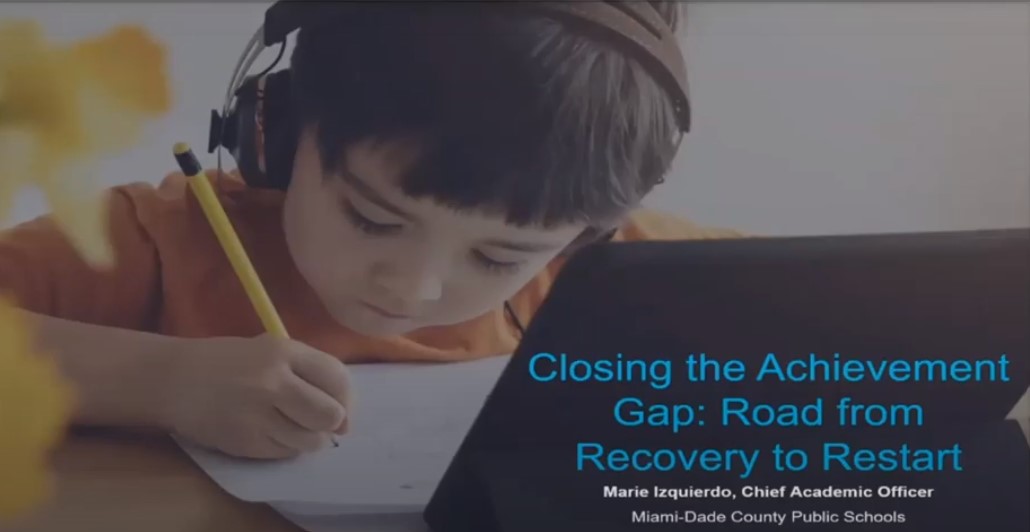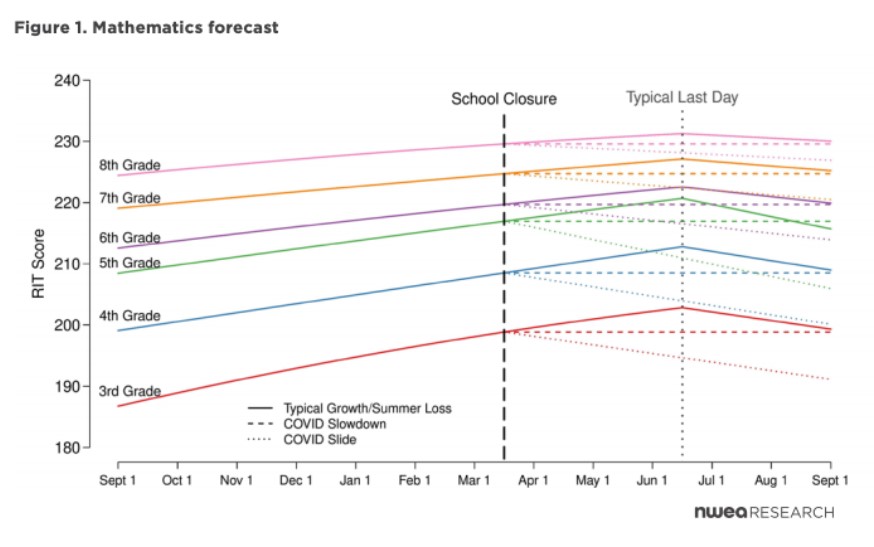Closing the Achievement Gap: The Road from Recovery to Restart
To help close the achievement gap, leaders in Miami-Dade County Schools have dedicated significant energy to ensuring students do not fall victim to summer slide

Parents and educators are well aware of the summer slide: That period when students go home for the summer and lose some of the learning gains they made throughout the school year, particularly in math and literacy.
Miami-Dade County Schools is the nation’s fourth-largest district, serving an extremely diverse population of 348,000 learners and supporting more than 20,000 teachers.
In her presentation during Tech & Learning’s recent “Future-Proofing Your District” virtual conference, the district’s Chief Academic Officer Marie Izquierdo shared how the district was tackling the challenges of what happens when summer starts in mid-March.
The COVID-19 Slide
According to Northwest Evaluation Association (NWEA), students in 3rd through 5th grade typically lose 20% of their literacy and 27% of their math knowledge during a regular summer.
This year, educators fear that “the COVID-19 slide” will be even more dramatic in terms of lost learning gains. According to NWEA research, those 3rd through 5th grade students may now see up to 30% literacy loss and as much as a 50% drop in math skills. The big drop in math is supported by a 2016 Harvard research study that shows most families don’t focus on math over the summer.

As you can see above, in some of the most severe cases, a student could regress as far as a grade level behind where they started. Leaders in Miami-Dade became alarmed when reviewing this data and sought to create a plan to try and stave off such a dramatic slide.
A Mitigation Plan
Using the tools learned during their Digital Convergence program, leaders and educators began working with the community on a seven-part plan to try and mitigate learning loss.
Tools and ideas to transform education. Sign up below.
1. Communication: Many teachers had already established organic ways of communication, so rather than push them to a single platform, they were allowed to communicate through their preferred tool. Teachers were also encouraged to use Microsoft Teams.
2. Most fragile students: Focusing on the most fragile students and zip codes became a priority. Migrant, ELL, and homeless students, and students with disabilities, were going to slip through the cracks without proper support. Using Title I personnel, educators reached out to and re-engaged students when they saw virtual absences. Services continued to be offered based on IEPs in the cloud.
3. Connectivity: Ensuring connectivity was ubiquitous became another priority. “This is a 21st century civil right,” said Izquierdo. Partnering with Sprint and other local Internet Service Providers (ISPs), leaders worked to ensure all families were connected to the web.
4. Maslow before Bloom - Rather than forcing curriculum remotely, teachers focused on meeting their students’ basic needs. This included being fed via food services and partnering with local restaurants in remote areas to provide food seven days per week.
5. Daily monitoring - Using dashboards such as Microsoft’s Power BI, administrators have been able to track student usage and log-ins for virtual attendance, and to check for disengaged students.
6. Engaging parents - Parents need to become partners in their child’s learning while navigating their own anxiety and stress. The district’s online parent academy has seen significant increased traffic, and offers many instructional webinars.
7. Development of summer programs - The continued use of summer programs, both virtual and in-person, will help in preventing summer learning losses.
A 3-Step Plan for Recovery
With all of these tools and strategies in place, Miami-Dade leaders have created a three-step plan to help recover learning loss by use of both traditional programs and a very non-traditional calendar.
Recover: Students in all grades that either needed course recovery or help with reading were given times during which they could participate in virtual boot camps through mid-July.
Regain: Students are given a series of E-Learning tools and challenges throughout the summer via their student portal. Additional EOC testing that was missed in the spring was also available for 9th and 10th grade students.
Restart: Students identified in the lower 25 percentile, as well as students with disabilities and ELL, will begin the school year on July 27. For all other students, there will be a compacted curriculum to review from the previous year and the school days will be extended to allow more time for recovery.
All of these plans take imagination and dedication to make a reality. While there is no data available on the actual loss of learning this summer, the leaders at Miami-Dade are doing their part to see that the slide is a short one.
Resources
- Summer Math Loss
- NWEA Research on COVID-19 Slide
- What is Power BI?
- Digital Convergence
- Instructional Continuity Plan
- ICP 2.0
- Resources for educators, families, students
- Virtual training for parents
Carl Hooker has been a part of a strong educational shift with technology integration since becoming an educator. As Director of Innovation & Digital Learning at Eanes ISD, he has helped spearhead the LEAP program, which put one-to-one iPads in the hands of all K-12 students in his 8000-student district. He is also the founder of “iPadpalooza”- a three-day “learning festival” held in Austin annually. He's also the author of the six-book series titled Mobile Learning Mindset, a guide for teachers, administrators, parents and others to support and embrace mobile learning in our schools. Read more at Hooked on Innovation.
Carl Hooker has spent the past 20+ years in education as a teacher and administrator focused on the thoughtful integration of technology and innovation. He consults for multiple districts across the country and is a frequent speaker at state and national events. In his free time he's an author, DJ, podcast host, Poetry Slammer, and Trivia Night MC. He's the co-founder of the social platform K12Leaders.com. Check out his latest book Ready Set FAIL! Now available for order here: https://mrhook.it/fail Read more of his blogs at Hooked on Innovation.
